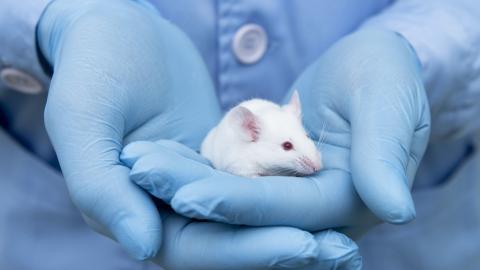- Overview
-
Species
MouseStrain common name
C57BL6/N (Trem2+/+, Trem2+/-, Trem2-/-)Full nomenclature
C57BL/6N-Trem2tm1(KOMP)Vlcg/MbpMmucdGenetic background
C57BL/6NDescription of model, including genes and any mutation(s):
Trem2: Knock-Out - Mouse line rederived and velocigene cassette excised to minimise artefact upregulation of Treml1.
Please see: https://www.alzforum.org/research-models/trem2-ko-kompOriginal publication of model
-Breeding scheme
-Type of model
Vascular cognitive impairment (i.e. chronic hypoperfusion) - Availability
-
Principal investigator
Dr Barry McCollInstitution
UK DRI at EdinburghNamed contact
Stefan SzymkowiakContact email
stefan.szymkowiak@ukdri.ac.ukSource of model
In-houseSupplier code
-MTA Holder and Issuing Organisation:
- - Intervention details
-
Intervention
StenosisStandard Operating Procedures for Intervention
https://drive.google.com/open?id=1FIi0oDJK28RI96KwURqvohtG0_4D-gmaAge at Surgery
Typically used at ages ranging from 3 months to 18+ monthsAnaesthetic
Inhalational isofluraneAnalgesics
Topical lidocaine to the wound siteAntibiotics
None - antibiotics can alter the neuroimmune responseThe size and duration between placement of microcoils will vary depending on experiment. Typically 0.18mm internal diameter (ID) microcoils are used bilaterally however use of 0.16mm ID microcoils wither bilaterally or in combination with 0.18mm ID microcoils will elicit more hypoperfusion and more severe/ extensive pathology. While 30 minutes is typically left between placement of microcoils, reducing this time is generally considered to result in more severe pathology whilst the opposite is observed if time between microcoil placement is increased above 30 minutes. Ensuring conistent timing of surgery (e.g. dissection and isolation of carotid arteries in 20 mins and placement of coils on artery (3-5 mins)) between animals is important for reducing variability.
- Study details
-
Sex
MaleAge of model
3-5 months, 6-8 months and 16 monthsDuration of Study
Various durations: 1 week, 1 month, 3 month and 7 monthDiet
Standard chowCage enrichment and housing
Typically in cages of 3 -5. Additional sizzle pet added for bedding and chewing stick included for environmental enrichment.Types of outcomes measured
Neurobehaviour (i.e. sensory, motor, cognition)Omics (i.e transcriptomics, proteomics, metabolomics)Physiology (i.e. body weight, BP)Structural measure (i.e. IHC, EM, structural MRI)Vascular function (i.e. BBB integrity, CBF)Details of Outcomes Measured
- Weight
- clinical score
- cerebral blood flow
- spatial learning and memory
- tissue pathology
- microglial specific changes
Standard Operating Procedures for Intervention
https://drive.google.com/open?id=1FIi0oDJK28RI96KwURqvohtG0_4D-gmaStrengths of Model
- Model can be manipulated (by changing type of microcoil used, time between microcoil placement or recovery period) to alter degree of cerebral blood flow changes and pathology severity.
- Mice exhibit pathologies and cognitive dysfunction relevant to human vascular cognitive disorders which develop/ progress with longer durations of hypoperfusion (white matter changes, vascular abnormalities, neuroinflammation etc). This provides users with a platform to investigate potential pathophysiological mechanisms and trial clinically relevant interventions (e.g. through genetic/ pharmacological manipulation).
Limitations of Model
- The model like most pre-clinical models does not recapitulate every aspect of the human form of disease.
- It is important to use C57Bl6 mice as the underdeveloped posterior communicating artery within the circle of Willis in this strain prevents effective compensation of cerebral blood flow changes enabling sufficient cerebral hypoperfusion. If mice have a developed posterior communicating artery, changes in cerebral blood flow are compensated and mice will not develop pathology.
- The model can be quite difficult technically and resulting pathological changes can be very mixed/ inconsistent making replication difficult. The reason behind inconsistencies are likely a combination of factors including mouse strain, quality of surgery, hygeine status of unit, cerebrovascular architecture of mice, temperature of surgery/ holding rooms and noise levels. It is therefore important to conduct a pilot study as optimisation likely, and control as many variables as possible.
Reference to published procedure
DOI: 10.1161/01.STR.0000143725.19053.60Details of any modications made to published procedure
The McColl lab typically use 0.16mm ID microcoils bilaterally to induce hypoperfusion as very subtle infrequent pathologies were detected in young mice using 0.18mm ID microcoils. 0.16mm ID microcoils could only be used on young adult mice as aged mice (12m and above) do not recover from surgery.
Image

Chronic cerebral hypoperfusion model
Vascular cognitive impairment (i.e. chronic hypoperfusion)